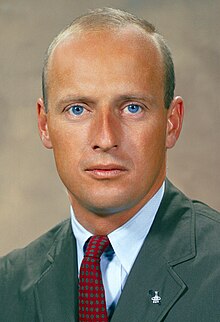
Back Pete Conrad Afrikaans تشارلز كونراد Arabic تشارلز كونراد ARZ Charles Conrad AST Pete Conrad BCL Чарлз Піт Конрад Byelorussian Чарлс Конрад Bulgarian পিট কনরাড Bengali/Bangla Charles Conrad Catalan چارڵز کۆنراد CKB
Pete Conrad | |
|---|---|
 Conrad in 1964 | |
| Born | Charles Conrad Jr. June 2, 1930 Philadelphia, Pennsylvania, U.S. |
| Died | July 8, 1999 (aged 69) Ojai, California, U.S. |
| Resting place | Arlington National Cemetery |
| Education | Princeton University (BS) |
| Spouses | |
| Children | 4 |
| Awards | |
| Space career | |
| NASA astronaut | |
| Rank | Captain, USN |
Time in space | 49d 3h 38m |
| Selection | NASA Group 2 (1962) |
Total EVAs | 4 |
Total EVA time |
|
| Missions | |
Mission insignia | |
| Retirement | December 1973 |
Charles "Pete" Conrad Jr. (June 2, 1930 – July 8, 1999) was an American NASA astronaut, aeronautical engineer, naval officer, aviator, and test pilot who commanded the Apollo 12 mission, on which he became the third person to walk on the Moon. Conrad was selected for NASA's second astronaut class in 1962.
Despite having dyslexia, Conrad earned his Bachelor of Science degree in aeronautical engineering from Princeton University—being the first Ivy League astronaut—and joined the U.S. Navy. In 1954 he received his naval aviator wings, served as a fighter pilot and, after graduating from the U.S. Naval Test Pilot School (Class 20), as a project test pilot. In 1959 he was an astronaut candidate for Project Mercury.
Conrad set an eight-day space endurance record in 1965 along with his Command Pilot Gordon Cooper on his first spaceflight, Gemini 5. Later, Conrad commanded Gemini 11 in 1966, and Apollo 12 in 1969. After Apollo, he commanded Skylab 2, the first crewed Skylab mission, in 1973. On the mission, he and his crewmates repaired significant launch damage to the Skylab space station. For this, President Jimmy Carter awarded him the Congressional Space Medal of Honor in 1978.
After Conrad retired from NASA and the Navy in 1973, he became a vice president of American Television and Communications Company. He went on to work for McDonnell Douglas, as a vice president. During his tenure, he served as vice president of marketing, senior vice president of marketing, staff vice president of international business development, and vice president of project development. He died on July 8, 1999, from internal injuries sustained in a motorcycle accident, aged 69.